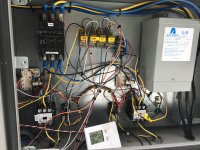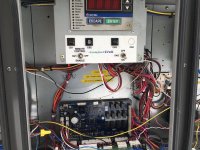I have spares for every fuse in the building in many formats from euro style to cartridge plus spare circuit breakers.
I only keep 3 of the TRS125R on hand since the only application is this unit… never needed to use one in 30 years.
I keep the 3 spares on the roof in the unit control cabinet.
Yesterday I told the tech I have spares on the roof and he said only one and it’s bad?
Turns out contractor used my spares and didn’t say anything and did not replace…
Several weeks ago this board in the same unit became toast… 5-6 weeks build from Carrier… none in North America per Carrier…
View attachment 3804314
If it were me, I'd buy a second board... I detest this trend in HVAC in particular of not stocking spares of even current equipment, especially for equipment with known track records of failures.
I can't tell from your photo, but there might be an electrical technician nearby who could repair the board, especially if you didn't lose a microcontroller. I do think I'd be wondering a bit about why some many pieces let out the magic smoke at once, and I would want to develop a plan to find and address the underlying cause. That's a lot of broken items.
Schrader valves? Without a gas tight over cap? That seems like a worse than poor design from this armchair. These days, at a distance, Carrier seems to have this diversity of designs, some good, and some in the pig's breakfast category, or worse.
Personally, I think that this lean manufacturing / just in time stocking concept is for the bean counters and the bean counters only. If one needs resilience, some amount of proactive planning and stocking is in order. (Not picking on you, just generally) A hospital I worked at had a pair of 1MW diesel generators that could cover 2/3rds of the hospital power in case of an outage, but they only had three days of diesel in the tank. I once asked what there plan was if the outage lasted longer than three days in, say, an earthquake. There response was that they would get a refill from somewhere, not even, "oh we have contracts with two fuel suppliers for refueling in case of emergency..." (and much less, no consideration of possible "force majeure" clauses in said contract post disaster...) To liven things up a bit more, the hospital was a mile or so from the San Andreas fault, specifically the segment most likely to rip in the next big one.

Yeah, I don't expect that hospital to be functioning when the big one hits.
I have done a lot of forward resiliency planning over the years. For items requiring sustained uptime, I tend to think about not having one 50T unit, and instead think of three or four 20T units, with resilient control management that can failover gracefully. With multiple small units in parallel, they can be loaded to efficient levels, the hours on service can be rotated and equalized, and servicing can be done without generally impacting user needs. It also is more cost effective than full duplication of resources. Yes, it requires a little more planning, but single point failures don't take everything down.
All the best,
Peter


